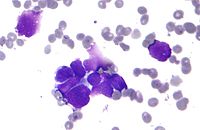
Photo from wikipedia
Purpose: There remains an unmet need to provide effective treatment therapy for patients with primary and metastatic brain tumors; lack of drug penetration across the blood brain barrier (BBB) is… Click to show full abstract
Purpose: There remains an unmet need to provide effective treatment therapy for patients with primary and metastatic brain tumors; lack of drug penetration across the blood brain barrier (BBB) is a key factor. Synthetic lethality remains an attractive mechanism in treating brain tumors post radiotherapy. Here, we evaluated brain penetration and distribution of niraparib and olaparib in a mouse brain tumor model. Experimental: Female mice (CrTac:NCr-Foxn1nu; 6 w/o) received 2.5E5 luciferase transfected human breast cancer line (MDA 231-BRM2-831) via intracardiac injection. Mice were imaged twice/week using bioluminescence imaging (BLI) to monitor tumor growth. On day 35, mice with brain metastases (BM) were treated via oral gavage once daily for 5 days with either niraparib (35 mg/kg, n=4 BM, n=3 control), olaparib (50 mg/kg, n=3 BM, n=3 control), or vehicle (n=3 control). Terminal blood samples and brains were collected 2 hr post final dose. Serial tissue sections were collected for MALDI-IMS, H&E and IHC staining from 5 distinct horizontal planes in the brain. Tissue collected between each imaging plane was homogenized for LC-MS bioanalysis. Summary of Data: In vivo BLI imaging was used to identify mice with BM and tumor presence was confirmed ex vivo using IHC. Quantitative MALDI IMS of coronal brain sections collected from mice administered niraparib showed consistent concentrations distributed throughout the brain parenchyma with locally higher concentrations detected from tumor regions. Table 1 summarizes the LC-MS bioanalysis concentrations in plasma and bulk brain homogenates and brain section concentrations detected by MALDI IMS. The estimated mean unbound brain-to-plasma partition coefficient (Kp,uu,brain) was 3.0x and 5.6x higher for niraparib compared to olaparib in control and BM mice, respectively. Conclusions: Herein, we demonstrated that niraparib has a higher brain penetration and distribution compared to olaparib in both control mice and mice with BM. Summary of Quantification Results Displayed as Total Conc. with Adjusted Free Conc. in Parentheses Compound Group Terminal Plasma Mean (ng/mL) LC-MS Bulk Brain Homogenate Mean (ng/g) MALDI IMS Brain Section Mean (ng/g) Kp,uu Brain Niraparib Control 3847 (769) 658 (111) 532 (89) 0.18 Niraparib BM 2535 (507) 543 (91) 473 (80) 0.14 Niraparib Vehicle BLQ BLQ Olaparib Control 226 (68) 6 (2) BLQ 0.06 Olaparib BM 119 (36) 5 (2) BLQ 0.03 Olaparib Vehicle BLQ BLQ Citation Format: Mark Reid Groseclose, Jeremy Barry, Tinamarie Skedzielewski, Gerald McDermott, Chakravarthi Balabhadrapatruni, Bill Benson, Yongle Pang, David K. Lim, Hoang Tran, Mike Ringenberg, Keyur Gada, Amine Aziez, Elaine Paul, Hasan Alsaid. Differentiation of niraparib and olaparib brain penetration in a mouse brain metastatic tumor model. [abstract]. In: Proceedings of the American Association for Cancer Research Annual Meeting 2023; Part 1 (Regular and Invited Abstracts); 2023 Apr 14-19; Orlando, FL. Philadelphia (PA): AACR; Cancer Res 2023;83(7_Suppl):Abstract nr 3582.
Journal Title: Cancer Research
Year Published: 2023
Link to full text (if available)
Share on Social Media: Sign Up to like & get
recommendations!